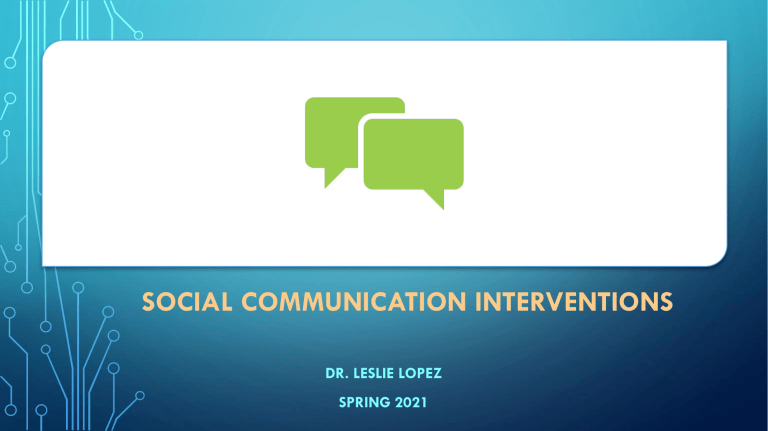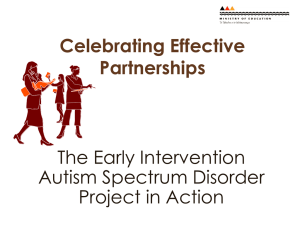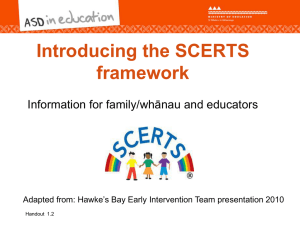
SOCIAL COMMUNICATION INTERVENTIONS DR. LESLIE LOPEZ SPRING 2021 HOW DO WE TAME THE SOCIAL COMMUNICATION DRAGON? How to Train Your Dragons 2, Dreamworks THE SPELL That will tame the dragon! Since there is not ONE profile, we will need more than ONE intervention! INTERVENTION CONSIDERATIONS YES • Make it functionally relevant • School-age: Curriculum-relevant • • language-based intervention Naturalistic Teaching Strategies (National Autism Center, 2015) Apply cognitive linguistic skills across modalities • Encourage self-evaluation, metacognitive skills • Self-Management (National Autism Center, 2015) • Utilize Evidence-Based Practice (ASD, language learning, reading disability literature) NO • Out of context “processing” interventions • Constantly giving evaluative feedback • Only focusing on one aspect of communication • Testing rather than teaching (Kamhi, 2014; Wallach, 2014) TREATMENT METHODS Consistent with the WHO (2001) framework, treatment is designed to • capitalize on strengths and address weaknesses related to the core features of ASD; • facilitate activities and participation by helping the individual acquire new communication skills and strategies or modify existing skills; and • modify contextual factors to reduce barriers and enhance facilitators of successful communication and participation, including identification and use of appropriate accommodations. (ASHA Practice Portal, n.d.) THE SCERTS MODEL The SCERTS Model is a comprehensive educational approach used with children of various ages, from preschool through school age (Prizant et al., 2006). SCERTS: THE BIG PICTURE • Multidisciplinary framework for working with children with ASD and families. • Guides professionals in developing a plan to support the learning of children with ASD. A Team Approach! • Individual Assessment Based • Focus is on “Social Communicative Competence”: functional, spontaneous communication across activities, environments, and people. (PRIZANT, WETHERBY, RUBIN, LAURENT, & RYDELL (2006 ) WHY FOCUS ON SOCIAL COMMUNICATIVE COMPETENCE? National Research Council findings point to this as a priority for educational goals. (Go to www.nap.edu for complete committee report); vol 1 pp. 111-114. Social communicative competence is predictive of later success (adult adaptive functioning). As social communicative competence increases, -Anxiety, depression, mental health disorders decrease. -Behavioral difficulties may be prevented or decreased. Target GOALS OF THE SCERTS MODEL Develop • Target challenges in everyday settings and activities. • Develop a plan to provide many opportunities for social communication, choice-making, and relating with others. Help • Help the child stay in the ZONE for learning. Plan • Have a plan for all professionals to be on the same page – team approach to prioritize goals and strategies – SHARED PRIORITIES Transitioning without tantrums Completing written assignments Sharing information in class T T T SLP SLP Math P.E./ Music/Art Recess Lang. Arts/ Reading Answering oral and written ‘why’ and ‘what’s next” questions appropriately Priority Goals Lunch Arrival/ Bell work Student: _____________ P/SpT Peers T T/P Peer Buddy Science/ Social Studies Infused or Embedded Skills Grid T/P T/P T T SLP SLP Adapted from: Beech, M., McKay, J.P., Barnitt, V., Orlando, C. (2002). Meaningful Participation: Planning Instruction for Students with Significant Disabilities. Tallahassee, FL: Florida Dept. of Education. T T SCERTS: BASIC PRINCIPLES Fostering functional and spontaneous communication is the most critical educational priority for children with ASD. Natural routines across home, school, and community provide the educational contexts for learning and for the development of positive relationships. Activities should be developmentally appropriate, functional, and meaningful Have meaningful measures of outcomes: beyond standardized measures. SCERTS: BASIC PRINCIPLES All behavior is viewed as purposeful. For children who display unconventional or problem behaviors, focus is on the function of the behavior and development of more appropriate ways to accomplish those functions. The way in which a communication partner interacts with a child with ASD and how an environment is adapted with learning supports, has a significant impact on that child’s social communicative competence. SCERTS STAGES Goals organized according to a continuum of three developmental stages: 1) Social Partner: children who are not yet using a symbolic system to communicate; use gestures/vocalizations 2) Language Partner: children who are using language/symbolic means (pics, signs, symbols, words). Do not yet carry on conversations. Can now use language to regulate self, so can use first/then, timers, etc. 3) Conversational Partner: use language/symbolic systems in reciprocal conversations. SCERTS TARGETS 1. 2. 3. Social Communication Emotional Regulation Transactional Supports These three areas are targeted because they “address the core challenges associated with ASD” SOCIAL COMMUNICATION (SC) • The primary challenge for many children with ASD • Two aspects of SC: 1) Joint Attention: help children be reciprocal in communication; to truly be social partners; “developing the ability to be a social partner in the dance of social reciprocity and social communication” (Prizant, video) SOCIAL COMMUNICATION (SC) 2) Symbol Use: the movement towards more conventional communication: gestures to pictures to words to complex language; children with ASD have trouble with developing abstract, symbolic systems; Also part of Symbol Use: play abilities. EXAMPLES OF JOINT ATTENTION GOALS ACROSS STAGES 1 Engages in reciprocal interaction 2 3 Shares attention Shares emotions 4 Shares intentions for a range of functions 5 Persists and repairs in communication 6 Shares experiences in reciprocal interaction SOCIAL PARTNER: JOINT ATTENTION (SC PIECE OF “SCERTS”) SOCIAL PARTNER: JOINT ATTENTION (SC PIECE OF “SCERTS”) CONVERSATIONAL PARTNER: JOINT ATTENTION (SC PIECE OF “SCERTS”) CONVERSATIONAL PARTNER: SYMBOL USE (SC PIECE OF “SCERTS”) THE HANEN PROGRAM INTERVENTIONS MORE THAN WORDS ® A PARENT-MEDIATED/PARENT-IMPLEMENTED INTERVENTION Who Attends More Than Words? Families of children with ASD or social-communication difficulties Led by Hanen Certified SLP PROGRAM FEATURES Offered to groups of parents (up to 8 families) of children with ASD Supported by user-friendly resources (parent guidebook, DVD, power point slides with video examples) PROGRAM OBJECTIVES • Parent education • Early communication intervention • Social support for parents Three Major Components 1. Pre-program assessment and baseline videotaping 2. Minimum of 17.5 hours of group training for parents 3. Three individual video feedback sessions for each parent/family MORE THAN WORDS STRATEGIES ® OWL – Observe, Wait, and Listen Give your child a reason to communicate and wait The Four “I”s – Include Your Child’s Interest, Interpret, Imitate, Intrude R.O.C.K. - Repetitive and Predictable; Outcome for child; Cue when needed; Keep it fun, Keep it going) The Four “S”s – Say Less, Stress, Go Slow, Show Visual Helpers FOLLOWING YOUR CHILD’S LEAD BEGINS WITH… O W L Observe your child What is he doing? Is he sending you a message? Wait Stop what you are doing Listen to your child Sounds/words Is he happy? Is he sending you a message? 28 Four “I”s of Interaction • Include Your Child’s Interests • Interpret • Imitate • Intrude 29 LET’S epeat what you say and do… • to start • to play • to finish Later… e-phrase what you say 30 LET’S ffer opportunities to send messages • Stop what you are doing and saying and wait for your child to send a message • Know when you will wait • Know how many times you will wait • Know how long you will wait 31 LET’S ue if you need to Cues to try first • Give a hint – Add a point or gesture – Look at your child or the object – Make a comment If your child still needs help • Get him started so he can do it – Start the action/word and wait – Add physical help – Say the first couple of words 32 LET’S eep it fun! • Include sensory eep it going! • Longer • With another person • In another activity Later… eep it changing • Don’t play it exactly the same way every time Use the Four “I”s: Include, Interpret, Imitate and Intrude 33 THE FOUR “S”S Say less and Stress Go Slow and Show Repeat often 34 More Than Words Program Schedule Pre-program consultation with each family 1. Get to Know More About Your Child’s Communication 2. Follow Your Child’s Lead Video 3. Make the Connection with People Games & Songs More Than Words® 35 More Than Words Program Schedule 4. Help Your child Understand What You Say; R.O.C.K. in Your Routines 5. Use Visual Helpers Video 6. Bring on the Books 7. Take out the Toys Video 8. Let’s Make Friends More Than Words® 36 Parent tries out newly learned strategies in an everyday activity with child VIDEO FEEDBACK SESSIONS SLP coaches the parent as needed to help the parent apply strategies successfully Parent and SLP view videotaped interaction together – SLP provides feedback to the parent, guiding discussion in order to increase the parent’s awareness of his/her interactive behavior and its’ impact on the child PIVOTAL RESPONSE TRAINING: ADDING RELATIONSHIP DEVELOPMENT BASICS • Pivotal response training (PRT) is a behavioral treatment intervention based on the principles of applied behavior analysis (ABA). • It is derived from the work of Koegel, Schreibman, Dunlap, Horner, and other researchers. It is a composite of the research on task interspersal, direct reinforcement, and role of choice. • PRT has demonstrated positive changes in these "pivotal behaviors" exhibiting widespread effects on many other behaviors associated with language and social interaction. Pivotal Response Training (PRT) provides a guideline for teaching skills and has been most successful for language, play and social interaction skills in children with autism. ISSUES Motivation • Children with ASD are difficult to motivate • Restricted interests are part of the diagnosis • Research suggests that motivation may be increased leading to a dramatic effect upon the children's learning (Koegel, O'Dell, & Dunlap, in press). ISSUES Responsivity to multiple cues • Attentional issues • Stimulus overselectivity • Lack of generalization PRINCIPLE 1 • Instructional opportunity should be clear • Instructional opportunity should be appropriate to task • Instructional opportunity should be uninterrupted • Child must be attending Avoid overly complex verbal instructions Avoid extraneous information PRINCIPLE 1: TIPS Limit instructing across long distances Try to give full attention Ensure attention Proximity Pause Add prosody, affect PRINCIPLE 2 Intersperse tasks already mastered with tasks that are more challenging • Increases motivation • Increases self confidence • Maintains previous skills PRINCIPLE 2: TIPS 1 2 Start activities with something already mastered Get child on a roll 3 Reinforce verbally, prosody, and with affect 4 Intersperse highly successful activities PRINCIPLE 3 Provide a role in choice for the child • Increases motivation • Shared control promotes turn taking PRINCIPLE 3: TIPS Choices are available almost everywhere • Play activity itself • Order of activities • Duration or number of activities • Choices within activity • Which song or book • What color • Crayon or marker • Environmental • Where to sit • What to sit on • Light on/off PRINCIPLE 4 INCREASE OPPORTUNITY FOR CHILD TO RESPOND TO MULTIPLE CUES PRINCIPLE 4: TIPS Add Increase Substitute Add descriptors Increase discrimination responsibilities Substitute paralinguistic information for verbal information PRINCIPLE 5 ANY RESPONSE TO THE CHILD'S BEHAVIOR MUST BE CONTINGENT UPON THE CORRECT BEHAVIOR OR ATTEMPT. Response must be immediate PRINCIPLE 5: TIPS Response must be appropriate Never reinforce incorrect Make sure to reinforce correct PRINCIPLE 6 Any goal-directed attempt to respond to questions, instructions, or opportunities should be reinforced. We don’t start out perfect PRINCIPLE 6 Look for attempts Successive approximations shapes behavior PRINCIPLE 7 Use natural reinforcers whenever possible Children who don’t make natural connections don’t gain meaning when reinforcers are disconnected with behavior

